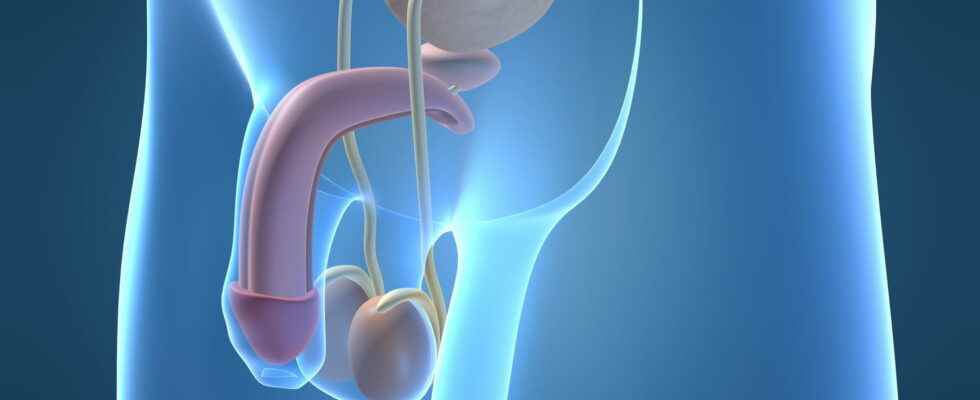The penis, also called “the penis”, is the sexual, reproductive and urinary organ of man. Anatomy explained with Dr Ludovic Ferretti, urologist surgeon.
Definition: what is the penis?
Also called yardthe penis is the male reproductive and urinary organ.
What is the role of the penis in men?
The penis allows you to urinate but also to reproduce. Reproduction is made possible through the erection of the penis, allowing vaginal penetration and then ejaculation including sperm.
Anatomy: what is the penis made of?
The human penis is different from that of animals. Indeed, in animals, the genital organ has a bone to facilitate penetration, while in humans, the latter is made possible thanks to the influx of blood at the time of erection. The human penis does not contain bone but two structures called “cavernous bodies” which, in the event of excitement, will fill with blood which will allow the stiffening of the penis and penetration during sexual intercourse. The penis is made up of three parts:
- the end with the glans of the penis,
- the middle with the body of the penis,
- and the root of the penis at the base.
Glans. At the end, the glans on which is the urethral meatus which corresponds to the opening of the urethra, the urinary canal.
Urethra. The urethra is the conduit which allows both the transport of urine from the bladder to the external environment during urination, but also ejaculation allowing the exit of semen containing the male gametes called spermatozoa, male cells of the reproduction.
Foreskin. The skin that covers the glans is called the foreskin. This skin is very thin and very innervated, which makes it an essential area for sexual stimulation.
Frenulum of the penis. On the underside of the glans is the frenulum, a fold of skin connecting the foreskin to the base of the glans. At the base of the glans is the crown of the glans.
penis body. The second part of the penis is the shaft of the penis, formed of erectile tissue which contains many blood vessels. We find there the spongy body which surrounds the urethra, and the two cavernous bodies on the top of the penis. These cavernous bodies are surrounded by an elastic envelope which allows elongation and increase in volume during erection.
Root of the penis. Finally, the third part is the root of the penis. It forms the base of the penis which is located inside the pelvis.
Diagram of the penis
Diseases of the penis
The penis can be affected by various dysfunctions : “La Peyronie’s disease is a fairly common condition. It most often appears after the age of 50, which can follow even minimal trauma to the erect penis. It can also affect much younger patients. Most often, a curvature of the penis appears in a few days or a few weeks, usually associated with erectile pain. A specialized consultation can be proposed in the event of an embarrassing impact on the reports”adds Dr. Ludovic Ferretti, urological surgeon, member of the Andrology and Sexual Medicine Committee of the AFU. “Phimosis consists of himinability to retract the glans totally because of too tight a foreskin. It should not be neglected because it exposes you to the risk of penile cancer in the event of predisposing factors (HPV infection, multiple reports, etc.). Finally, priapism does not manifest by “a prolonged erection (more than 3 hours) leading to ischemia of the penis. The blood can no longer circulate, the cavernous tissue allowing the erection is destroyed. This condition may be due to a taking medication, certain blood diseases (sickle cell disease, leukemia, etc.), but most often no cause is really found. A consultation must be carried out urgently for a specialized intervention because of the erectile prognosis modeled on the delay in treatment. Indeed, after more than 24 hours, the chances of regaining a natural erection is very low. emphasizes Dr. Ludovic Ferretti.
penis exams
Doctor asks the patient about any recent pain or symptoms. He will make a clinical examination of the penis and testicles as well as groin glands in order to detect any inflammation, lesion, ulceration, tumor or morphological abnormality. If cancer is suspected, the diagnosis should be with a biopsy which consists of surgically removing a piece of tissue from the penis, which is subjected to microscopic examination and biochemical analysis. It is also possible to pass a ultrasound of the penis, in the management of trauma (such as a fracture of the penis). “A MRI in erection is useful in the assessment of a tumor of the penis“, adds Dr. Ludovic Ferretti. In case of erectile dysfunctionthe patient may be asked to perform blood tests to measure glycaemia (blood sugar level), creatinaemia (to assess kidney function) or testosterone levels. Without forgetting “the lipid profile” to screen for cardiovascular risk factors.
On the health forum: discussions about the penis
To remember
► The penis allows urination and reproduction. Reproduction is made possible through erection and then ejaculation.
► The human penis does not contain bone but two cavernous bodies which in case of excitement fill with blood (erection).
► The penis can fracture during sexual intercourse.
► The man can experience premature ejaculations, in a systematic and uncontrolled way, but also delayed ejaculations.
► A curvature of the penis and pain in erections are signs of Lapeyronie’s disease.
Thanks to Dr. Ludovic Ferretti, urological surgeon. Comments collected in 2019.
